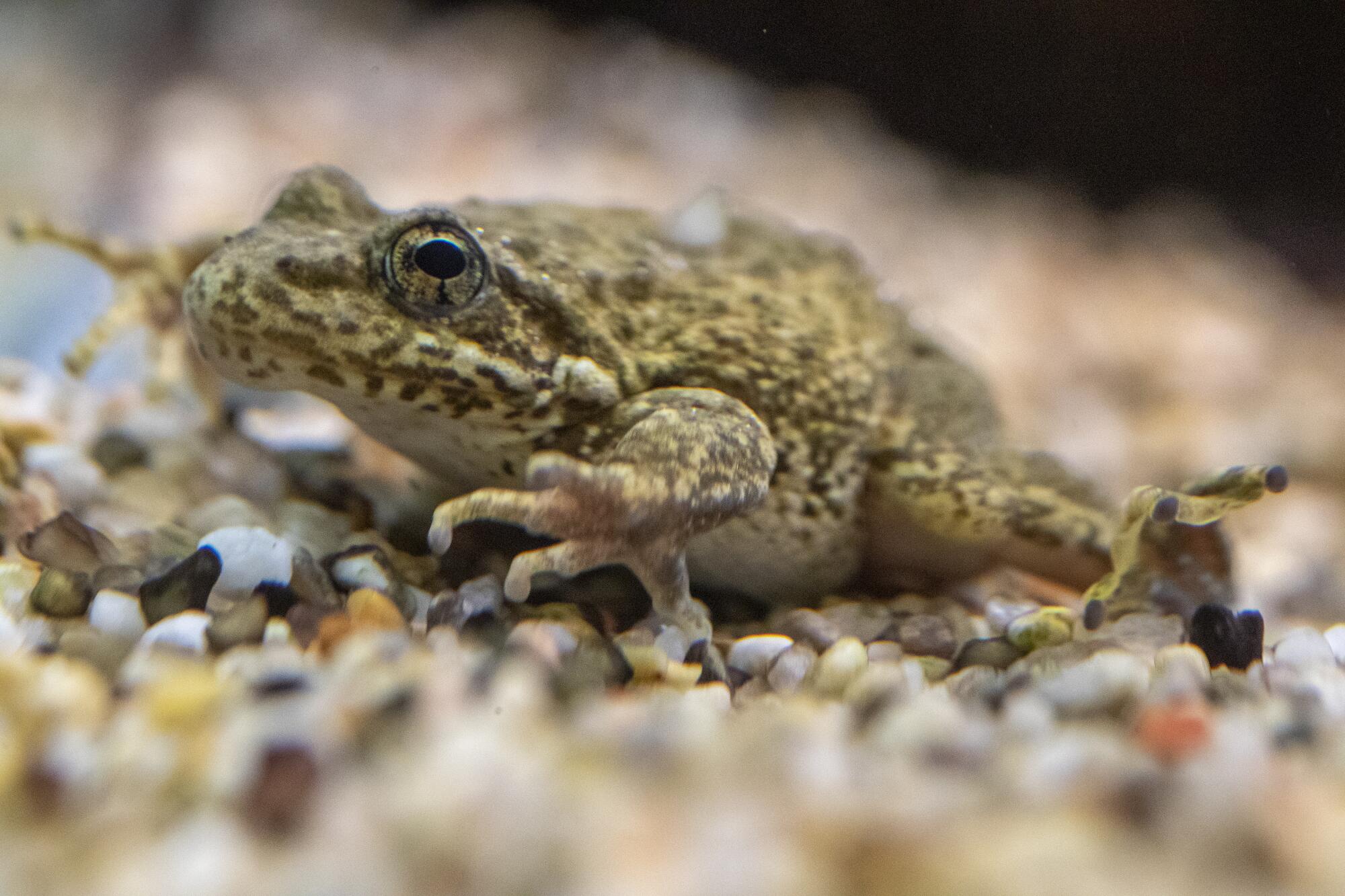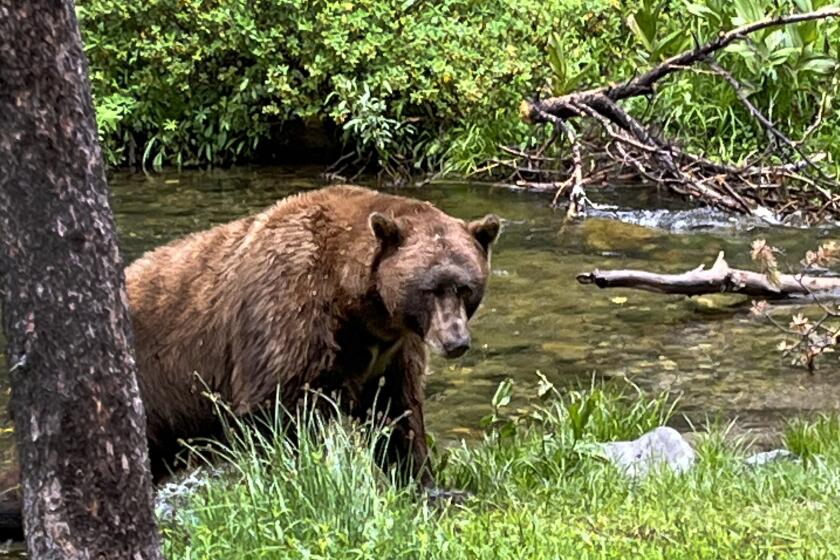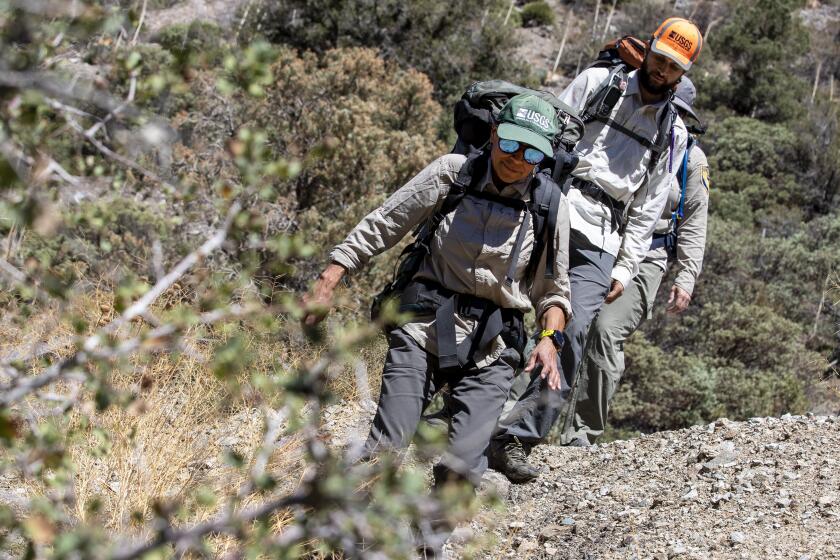
- Share via
Endangered frogs snatched as tadpoles from fire-ravaged mountains above Los Angeles in 2020 were returned home last year in a moment of hope and excitement.
But the California amphibians are once again in the line of fire and another rescue mission could be in the cards.
Massive wildfires are raging through the San Gabriel and San Bernardino mountains — two of the three ranges where Southern California mountain yellow-legged frogs eke out a fragile existence in a handful of isolated streams. As of Saturday, the fires had chewed through more than 90,000 acres and there is worry the flames may be encroaching on the frog’s critical habitat.
The federally endangered frogs are “a high priority because these fires are in the only known locations” for the species, said Hans Sin, a biologist for the California Department of Fish and Wildlife’s South Coast region. The San Jacinto Mountains, in Riverside County, are their only other hopping grounds.
Victor the bear was notorious for mooching meals at Mammoth Lakes campgrounds, but when he crashed a steak and wine dinner, things escalated quickly.
On Thursday, Sin met with the U.S. Forest Service, U.S. Fish and Wildlife Service and the U.S. Geological Survey to work out a game plan for the frogs of the San Gabriels. (The San Bernardino range is served by a different CDFW region.)
As soon as it’s safe, he said, staff will trek into the craggy hills and assess what happened to the frogs.
Depending on what they find, “We might need to do a rescue of said frogs,” Sin said.
That could entail hiking them out in coolers and taking them to zoos, where they’d enter conservation breeding programs. It might also involve plunking them into other streams that could sustain them.
“Each population is small and highly susceptible to stochastic events, especially wildfire,” notes a five-year status review for the frogs released last month by the U.S. Fish and Wildlife Service.
Mountain yellow-legged frogs are named for their lemon-hued bellies and hind legs.

If swooping in to save them sounds dramatic, consider their plight: Once common in the alpine reaches of the southern Sierra Nevada and Transverse mountain ranges, they’ve disappeared from 99% of their historical range, by some estimates. In Southern California, fewer than 200 of the medium-size frogs are believed to exist in the wild.
Climate change-fueled fires and prolonged drought are among the culprits for their stunning decline. Loss of riparian habitat due to development, stream channelization and other factors has robbed the mountain frogs of habitat. Their woes have also been compounded by disease and predation by nonnative trout. Cannabis cultivation and recreation haven’t helped either, experts say.
According to Sin, it’s the secondary effects of fire that pose the greatest threat. Fierce wildfires can transform green canopies and undergrowth to gray ash. After that, the next rain then sweeps denuded earth and debris into streams, physically displacing the frogs and other inhabitants and making it harder for them to forage.
When the forest is on fire, “a frog is going to jump in the water and hide itself,” Sin said. “Whether a burning, rolling log comes down and hits [it], I don’t think that is as likely.”
The Bobcat fire, the second-largest blaze in L.A. County’s recorded history, charred more than 100,000 acres, and made an impact on at least five “occurrences” of frogs in the San Gabriels, according to the status review.
Though the frogs are of special concern, they’re not the only water-dwellers that could be in trouble.
As streams dry up in the San Gabriel Mountains, biologists are searching harder for suitable areas to reintroduce a rare frog species.
There’s also heightened concern for the western pond turtle, California’s only native freshwater turtle and a candidate for federal protection. While the turtles are found in more areas than the frogs, they’ve seen stark declines.
Rescues and releases — of the frogs, turtles and other sensitive species — happen with some regularity.
Just last month, Sin said USGS and CDFW crews saved juvenile frogs from an area in the San Gabriels where the population had “crashed” in a short amount of time. Last year, they logged 140 adult frogs. This year, they found none. But they found some youngsters and hauled them out.
The federal status review notes that habitat in Little Rock Creek in the San Gabriels was “long considered a stronghold” for the frogs but just one adult was found in surveys this year. The area, home to what was once a premier rock climbing destination, is closed to the public.

Around the same time the young frogs were rescued, a batch of the diminutive pond turtles that were ferried away from the charred San Gabriels after the Bobcat fire were brought back.
The irony of situation wasn’t lost on Sin.
“We didn’t expect the fire to happen like a month after release,” he said. “Sometimes, wow, we can’t predict the future. It’s just unfortunate.”
Releasing mountain yellow-legged frogs at new locations and beefing up existing enclaves is helping, the recent status review concluded.
However, threats have not meaningfully changed or subsided since the last review in 2019.
When it comes to climate change and wildfire, the report states, “the timing and options available to reduce these threats are either limited or unclear.”









